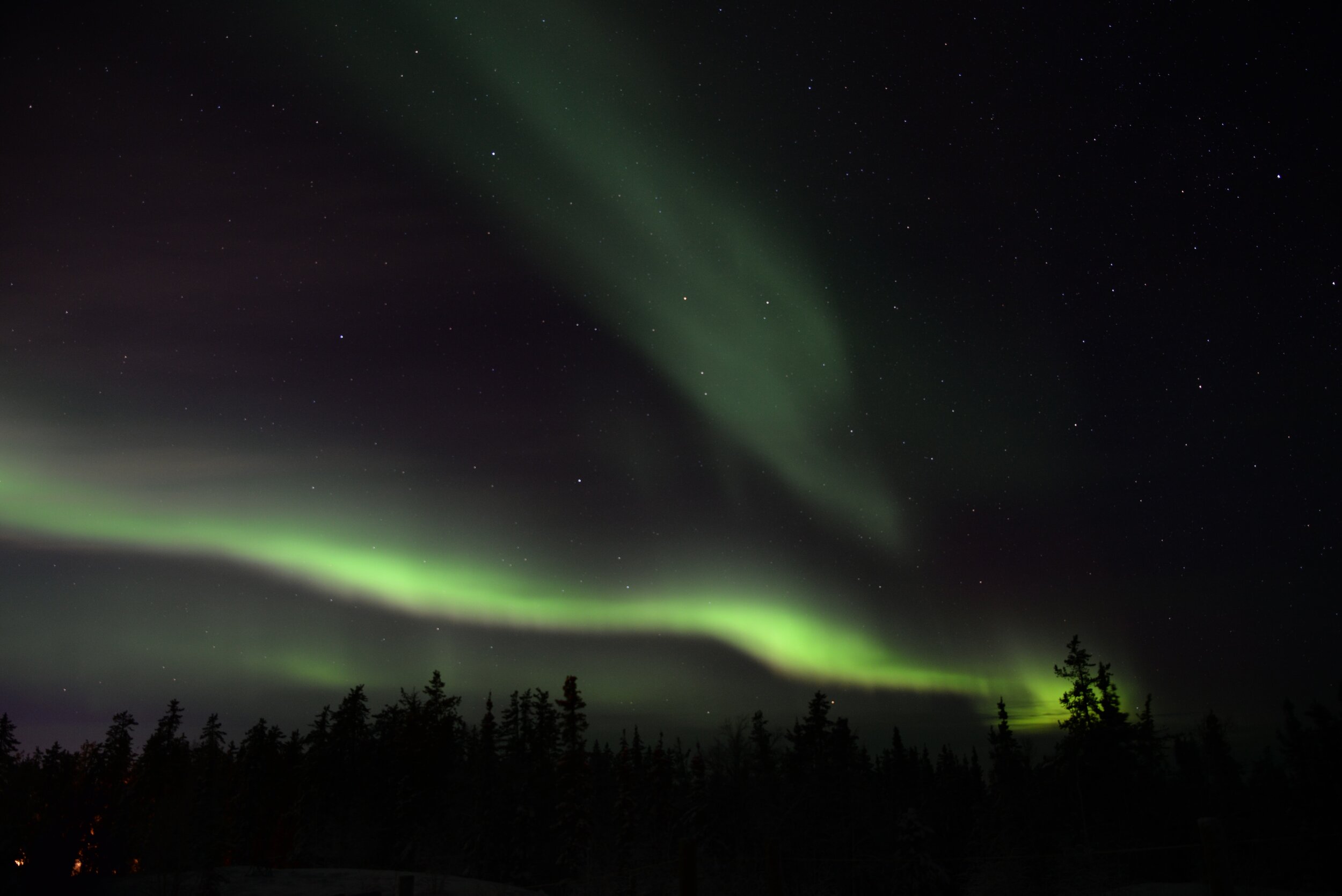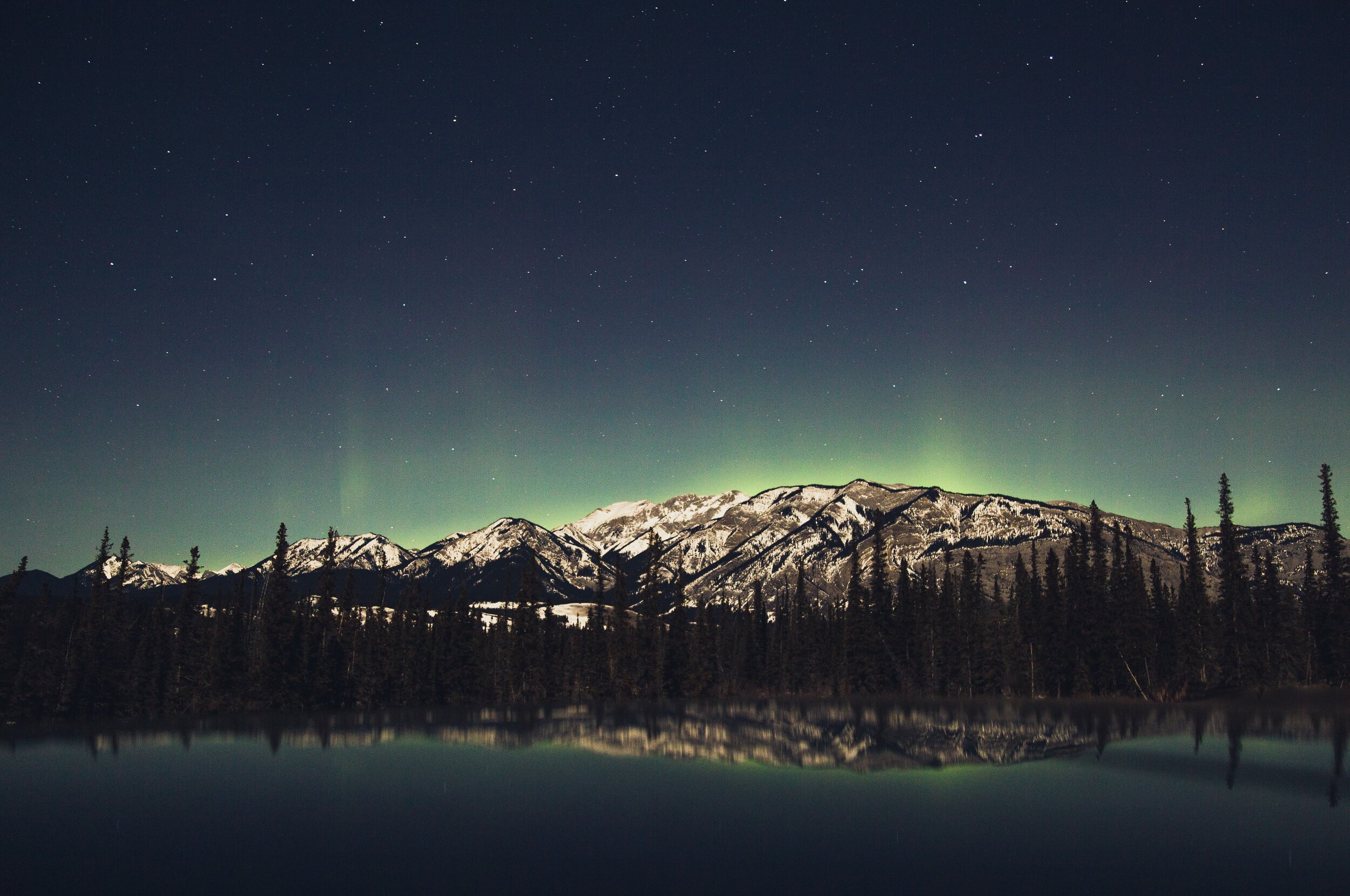“Outside, though perhaps morning, it is still night, but a night of a thousand thrusting colors laid over the shaking stars.” ― Dan Simmon
Growing up in Southern Ontario I had seen the Northern Lights (faintly) once or twice, but it wasn’t until I moved West to Alberta that I spotted them for the first time in a much more obvious way … that is to say that I looked up and thought “WTF is happening right now?!”
Here in the city of Edmonton the Northern Lights aren’t necessarily uncommon, but they certainly require the perfect conditions to view them from the comfort of home.
Although Environment Canada reports nearly 90 nights each year when the lights should be viewable from the city, there are many more locations throughout the Province where viewing conditions are more favorable. So if you are planning a trip through Alberta, here are some beautiful spots (listed North to South) that you can visit to increase your chances of viewing the Aurora Borealis.
Please Note: Darkness is an essential requirement for viewing the Northern Lights which can be seen year round in Canada. With geomagnetic activity on the rise during the Spring and Fall however, September and March tend to be Alberta’s peak viewing months.
Wood Buffalo National Park
Located on Alberta’s Northern Provincial border with the Northwest Territories, Wood Buffalo National Park is the northernmost preserve in Alberta and the world’s largest dark-sky preserve where artificial light is nearly non-existent.
Its dark sky and Northern location makes Wood Buffalo National Park a bucket list destination for aurora chasers worldwide, and the Northern Lights can be observed here starting as early as late August.
While Wood Buffalo National Park is arguably one of the Province’s best viewing locations, it is also the most secluded and visitors to Wood Buffalo National Park will need to fly North to Fort McMurray (Alberta’s gateway to the Park) before beginning their viewing adventures.
Please Note: Road access to Fort McMurray and Wood Buffalo National Park is also available, however winter driving through Northern Alberta is not advised as it can be treacherous, icy and requires a great deal of winter driving experience.
Athabasca
Heading South from Wood Buffalo National Park (much further South in fact) you will find the Athabasca University Geophysical Observatory; a research center that studies the magnetic effects of the aurora borealis.
While the Observatory itself is closed to the public, its general location in the Athabasca region makes it perfect for viewing the Northern Lights. View the Northern Lights in Athabasca from Muskeg Creek Park or from the banks of the Athabasca River.
Beaver Hills Dark Sky Preserve
Two hours South from Athabasca you will find the Beaver Hills Dark Sky Preserve. Beaver Hills is a 300 square km preserve located 1 hour East of the city of Edmonton and is comprised of both Elk Island National Park as well as the Cooking Lake-Blackfoot Provincial Recreation Area.
Still considered to be a Northern viewing location, Beaver Hills is much more easily accessible from the Provincial Capital and its reduction in artificial light increases visibility making it one of the best locations from which to view the Northern Lights or stargaze year round.
Jasper National Park
Located in the Canadian Rocky Mountains, Jasper National Park is the second largest Dark Sky Preserve in the world and provides visitors with optimum darkness for viewing the Northern Lights.
In fact, Jasper National Park is so popular with visitors to Alberta that they even host an annual Dark Sky Festival in the park that includes a host of activities where travelers can learn about the constellations and photograph the night sky.
One of the most popular locations in Jasper for viewing the Northern Lights is Pyramid Lake, so if you are looking for somewhere to splurge on a luxury accommodation, consider a stay at the beautiful Pyramid Lake Resort for your best shot at stunning views between September and March.
Banff National Park
Although Banff National Park is certainly the southernmost location on this list, it still offers visitors a chance at spotting the Northern Lights outside of town and away from the light pollution.
Lake Minnewanka is a popular viewing location just ten minutes from town, however further locations like Peyto Lake or Kananaskis are also recommended for ample darkness on a cloudless night.
Top Tips for Your Trip
It is important to remember that the Northern Lights can be unpredictable and optimal viewing depends on the time of year, time of night, weather conditions and geomagnetic activity … so patience is key.
For your best chance at catching the Northern Lights, use this light pollution map to scout out the locations with the least amount of light pollution in your area and consult the Aurora Forecast for an advanced forecast on geomagnetic activity levels.
When visiting, it is also important to keep in mind that professional photographers use very specific exposure techniques to capture the images that you see online, so while the Northern Lights may be strong as you are viewing them in person, they may appear weaker if you are trying to capture them to share.
So take note and start planning your trip to the North to view the stunning Aurora Borealis and explore some of Canada’s most beautiful parks and preserves while you’re at it.
Oh, and don’t forget to bundle up … because it gets cold out there!
Have you ever seen the Northern Lights in person? Let me know when and where in the comments below.
Photo contributions for this post from unsplash.








